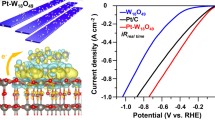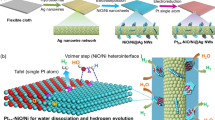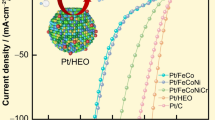Abstract
Developing high-performance single-atom platinum (Pt) catalysts for acidic hydrogen evolution reaction (HER) is of significance. However, their HER kinetics are limited due to the low concentration of hydrogen ions (H+) near the Pt sites in acidic electrolytes, where hydronium ions are undesirably formed with H+ surrounded by water molecules. Here, we seek to improve the HER kinetics by anchoring single-atom Pt catalyst on nanoneedle-shaped protonated polyaniline supports, which can not only capture H+ from the hydronium ions but also facilitate the electroreduction of H+ by promoting the electron accumulation. As a result, the turnover frequency of single-atom Pt supported on the nanoneedle-shaped protonated polyaniline is appreciably enhanced, compared with that of the single-atom Pt supported on the flat-shaped protonated polyaniline. By combining the X-ray photoelectron spectroscopy, finite-element simulation and electrochemical studies, we find that the enhanced HER activity of single-atom Pt on nanoneedle-shaped protonated polyaniline support may arise from a hydrogen spillover pathway induced by the increased local concentration of H+ near the Pt sites.

摘要
开发高性能单原子铂催化剂对酸性电解水制氢领域具有重要意义. 在酸性电解液中, 氢离子(H+)会被水分子包围并形成水合氢离子, 这会导致单原子铂活性位点的局部H+浓度降低, 从而使其析氢反应动力学受到限制. 本研究通过将单原子铂负载在纳米针尖状质子化聚苯胺上, 它既能捕获水合氢离子中的H+, 又能通过促进电荷积累以加快H+的电化学还原, 从而提高单原子铂的析氢反应动力学. 结果表明, 相比于扁平状质子化聚苯胺负载的单原子铂, 针尖状质子化聚苯胺负载的单原子铂的析氢反应转换频率得到显著提高. 结合X射线光电子能谱、 有限元模拟和电化学行为研究, 我们发现局部H+富集促使的氢溢流现象对提升纳米针尖状质子化聚苯胺负载的单原子铂催化剂的析氢活性具有重要贡献.
Similar content being viewed by others
References
Yang J, Mohmad AR, Wang Y, et al. Ultrahigh-current-density niobium disulfide catalysts for hydrogen evolution. Nat Mater, 2019, 18: 1309–1314
Mahmood J, Li F, Jung SM, et al. An efficient and pH-universal ruthenium-based catalyst for the hydrogen evolution reaction. Nat Nanotech, 2017, 12: 441–446
Zhang X, Zhang Y, Li F, et al. Oxomolybdate anchored on copper for electrocatalytic hydrogen production over the entire pH range. Appl Catal B-Environ, 2019, 249: 227–234
Zang W, Sun T, Yang T, et al. Efficient hydrogen evolution of oxidized Ni-N3 defective sites for alkaline freshwater and seawater electrolysis. Adv Mater, 2021, 33: 2003846
Hou J, Peng X, Sun J, et al. Accelerating hydrazine-assisted hydrogen production kinetics with Mn dopant modulated CoS2 nanowire arrays. Inorg Chem Front, 2022, 9: 3047–3058
Yang M, Liu Y, Sun J, et al. Integration of partially phosphatized bimetal centers into trifunctional catalyst for high-performance hydrogen production and flexible Zn-air battery. Sci China Mater, 2022, 65: 1176–1186
Ding J, Yang H, Zhang S, et al. Advances in the electrocatalytic hydrogen evolution reaction by metal nanoclusters-based materials. Small, 2022, 18: 2204524
Zhang K, Liang X, Wang L, et al. Status and perspectives of key materials for PEM electrolyzer. Nano Res Energy, 2022, 1: e9120032
Liu T, Gao W, Wang Q, et al. Selective loading of atomic platinum on a RuCeOx support enables stable hydrogen evolution at high current densities. Angew Chem Int Ed, 2020, 59: 20423–20427
Li X, Chen Z, Yang Y, et al. Highly stable and efficient Pt single-atom catalyst for reversible proton-conducting solid oxide cells. Appl Catal B-Environ, 2022, 316: 121627
Kim T, Roy SB, Moon S, et al. Highly dispersed Pt clusters on F-doped tin(IV) oxide aerogel matrix: An ultra-robust hybrid catalyst for enhanced hydrogen evolution. ACS Nano, 2022, 16: 1625–1638
Liu D, Li X, Chen S, et al. Atomically dispersed platinum supported on curved carbon supports for efficient electrocatalytic hydrogen evolution. Nat Energy, 2019, 4: 512–518
Chen C, Ou W, Yam KM, et al. Zero-valent palladium single-atoms catalysts confined in black phosphorus for efficient semi-hydrogenation. Adv Mater, 2021, 33: 2008471
Chao G, An X, Zhang L, et al. Electron-rich platinum electrocatalysts supported onto tin oxides for efficient oxygen reduction. Compos Commun, 2021, 24: 100603
Dutta B, Wu Y, Chen J, et al. Partial surface selenization of cobalt sulfide microspheres for enhancing the hydrogen evolution reaction. ACS Catal, 2019, 9: 456–465
Kim D, Sohn Y, Jang I, et al. Formation mechanism of carbon-supported hollow PtNi nanoparticles via one-step preparations for use in the oxygen reduction reaction. Catalysts, 2022, 12: 513
Li C, Chen Z, Yi H, et al. Polyvinylpyrrolidone-coordinated single-site platinum catalyst exhibits high activity for hydrogen evolution reaction. Angew Chem Int Ed, 2020, 59: 15902–15907
Jiao S, Kong M, Hu Z, et al. Pt atom on the wall of atomic layer deposition (ALD)-made MoS2 nanotubes for efficient hydrogen evolution. Small, 2022, 18: 2105129
Wang W, Wu Y, Lin Y, et al. Confining zero-valent platinum single atoms in α-MoC1−x for pH-universal hydrogen evolution reaction. Adv Funct Mater, 2022, 32: 2108464
Lu F, Yi D, Liu S, et al. Engineering platinum-oxygen dual catalytic sites via charge transfer towards highly efficient hydrogen evolution. Angew Chem Int Ed, 2020, 59: 17712–17718
Jin H, Sultan S, Ha M, et al. Simple and scalable mechanochemical synthesis of noble metal catalysts with single atoms toward highly efficient hydrogen evolution. Adv Funct Mater, 2020, 30: 2000531
Zhu J, Cai L, Yin X, et al. Enhanced electrocatalytic hydrogen evolution activity in single-atom Pt-decorated VS2 nanosheets. ACS Nano, 2020, 14: 5600–5608
Yan QQ, Wu DX, Chu SQ, et al. Reversing the charge transfer between platinum and sulfur-doped carbon support for electrocatalytic hydrogen evolution. Nat Commun, 2019, 10: 4977
Greiner MT, Jones TE, Beeg S, et al. Free-atom-like d states in single-atom alloy catalysts. Nat Chem, 2018, 10: 1008–1015
Mondal S, De SK, Jana R, et al. Unveiling the excellent electrocatalytic activity of grain-boundary enriched anisotropic pure gold nanostructures toward hydrogen evolution reaction: A combined approach of experiment and theory. ACS Appl Energy Mater, 2021, 4: 3017–3032
He T, Wang W, Yang X, et al. Deposition of atomically thin Pt shells on amorphous palladium phosphide cores for enhancing the electrocatalytic durability. ACS Nano, 2021, 15: 7348–7356
Fang S, Liu Y, Sun Z, et al. Photocatalytic hydrogen production over Rh-loaded TiO2: What is the origin of hydrogen and how to achieve hydrogen production from water? Appl Catal B-Environ, 2020, 278: 119316
Zhang J, Li Y, Wang Z, et al. Three-dimensionally hierarchical Ni-CoP@PANI architecture for high-performance hydrogen evolution reaction. Nanotechnology, 2020, 31: 445401
Wang Q, Gao Y, Ma Z, et al. Supported ionic liquid phase-boosted highly active and durable electrocatalysts towards hydrogen evolution reaction in acidic electrolyte. J Energy Chem, 2021, 54: 342–351
Zong W, Lian R, He G, et al. Vacancy engineering of group VI anions in NiCo2A4 (A = O, S, Se) for efficient hydrogen production by weakening the shackles of hydronium ion. Electrochim Acta, 2020, 333: 135515
Zhu J, Hu L, Zhao P, et al. Recent advances in electrocatalytic hydrogen evolution using nanoparticles. Chem Rev, 2020, 120: 851–918
Wang H, Wang W, Yu H, et al. Interface engineering of polyaniline-functionalized porous Pd metallene for alkaline oxygen reduction reaction. Appl Catal B-Environ, 2022, 307: 121172
Hu J, Li SS, Li JF, et al. Surface functionalization of polyaniline and excellent electrocatalytic performance for oxygen reduction to produce hydrogen peroxide. Chem Eng J, 2022, 431: 133921
Wang D, Yang L, Liu H, et al. Polyaniline-coated Ru/Ni(OH)2 nanosheets for hydrogen evolution reaction over a wide pH range. J Catal, 2019, 375: 249–256
Feng JX, Tong SY, Tong YX, et al. Correction to “Pt-like hydrogen evolution electrocatalysis on PANI/CoP hybrid nanowires by weakening the shackles of hydrogen ions on the surfaces of catalysts”. J Am Chem Soc, 2019, 141: 13698
Liu M, Pang Y, Zhang B, et al. Enhanced electrocatalytic CO2 reduction via field-induced reagent concentration. Nature, 2016, 537: 382–386
Gao FY, Hu SJ, Zhang XL, et al. High-curvature transition-metal chalcogenide nanostructures with a pronounced proximity effect enable fast and selective CO2 electroreduction. Angew Chem Int Ed, 2020, 59: 8706–8712
Liu P, Chen B, Liang C, et al. Tip-enhanced electric field: A new mechanism promoting mass transfer in oxygen evolution reactions. Adv Mater, 2021, 33: 2007377
Jiang H, Hou Z, Luo Y. Unraveling the mechanism for the sharp-tip enhanced electrocatalytic carbon dioxide reduction: The kinetics decide. Angew Chem Int Ed, 2017, 56: 15617–15621
He S, Hu X, Chen S, et al. Needle-like polyaniline nanowires on graphite nanofibers: Hierarchical micro/nano-architecture for high performance supercapacitors. J Mater Chem, 2012, 22: 5114
Liu S, Wan K, Zhang C, et al. Polyaniline-decorated 3D carbon porous network with excellent electrolyte wettability and high energy density for supercapacitors. Compos Commun, 2021, 24: 100610
Gao H, Xue L, Xin S, et al. A high-energy-density potassium battery with a polymer-gel electrolyte and a polyaniline cathode. Angew Chem Int Ed, 2018, 57: 5449–5453
Sun Y, Zheng J, Yang Y, et al. Design advanced porous polyaniline-PEDOT:PSS composite as high performance cathode for sodium ion batteries. Compos Commun, 2021, 24: 100674
Kuang P, Wang Y, Zhu B, et al. Pt single atoms supported on N-doped mesoporous hollow carbon spheres with enhanced electrocatalytic H2-evolution activity. Adv Mater, 2021, 33: 2008599
Hanselman CL, Zhong W, Tran K, et al. Optimization-based design of active and stable nanostructured surfaces. J Phys Chem C, 2019, 123: 29209–29218
Li XB, Gao YJ, Wang Y, et al. Self-assembled framework enhances electronic communication of ultrasmall-sized nanoparticles for exceptional solar hydrogen evolution. J Am Chem Soc, 2017, 139: 4789–4796
Sun LH, Li QY, Zhang SN, et al. Heterojunction-based electron donators to stabilize and activate ultrafine Pt nanoparticles for efficient hydrogen atom dissociation and gas evolution. Angew Chem Intl Edit, 2021, 60: 25766–25770
Li J, Zhou Y, Tang W, et al. Cold-plasma technique enabled supported Pt single atoms with tunable coordination for hydrogen evolution reaction. Appl Catal B-Environ, 2021, 285: 119861
Li R, Xu J, Zhao Q, et al. Cathodic corrosion as a facile and universal method for the preparation of supported metal single atoms. Nano Res, 2022, 15: 1838–1844
Wei W, Wang G, Yang S, et al. Efficient coupling of nanoparticles to electrochemically exfoliated graphene. J Am Chem Soc, 2015, 137: 5576–5581
Li X, Rafie A, Smolin YY, et al. Engineering conformal nanoporous polyaniline via oxidative chemical vapor deposition and its potential application in supercapacitors. Chem Eng Sci, 2019, 194: 156–164
Li J, Liu HX, Gou W, et al. Ethylene-glycol ligand environment facilitates highly efficient hydrogen evolution of Pt/CoP through proton concentration and hydrogen spillover. Energy Environ Sci, 2019, 12: 2298–2304
Feng Y, Feng W, Wan J, et al. Spherical vs. planar: Steering the electronic communication between Ru nanoparticle and single atom to boost the electrocatalytic hydrogen evolution activity both in acid and alkaline. Appl Catal B-Environ, 2022, 307: 121193
Cheng Y, Lu S, Liao F, et al. Rh-MoS2 nanocomposite catalysts with Pt-like activity for hydrogen evolution reaction. Adv Funct Mater, 2017, 27: 1700359
Dai J, Zhu Y, Chen Y, et al. Hydrogen spillover in complex oxide multifunctional sites improves acidic hydrogen evolution electro-catalysis. Nat Commun, 2022, 13: 1189
Fu HQ, Zhou M, Liu PF, et al. Hydrogen spillover-bridged Volmer/Tafel processes enabling ampere-level current density alkaline hydrogen evolution reaction under low overpotential. J Am Chem Soc, 2022, 144: 6028–6039
Li J, Hu J, Zhang M, et al. A fundamental viewpoint on the hydrogen spillover phenomenon of electrocatalytic hydrogen evolution. Nat Commun, 2021, 12: 3502
Warren JJ, Tronic TA, Mayer JM. Thermochemistry of proton-coupled electron transfer reagents and its implications. Chem Rev, 2010, 110: 6961–7001
Koper MTM. Theory of the transition from sequential to concerted electrochemical proton-electron transfer. Phys Chem Chem Phys, 2013, 15: 1399–1407
Koper MTM. Theory of multiple proton-electron transfer reactions and its implications for electrocatalysis. Chem Sci, 2013, 4: 2710–2723
Acknowledgements
This work was financially supported by the National Natural Science Foundation of China (52103260, 52161135302, and 52211530489), the Research Foundation Flanders (G0F2322N), the Natural Science Foundation of Jiangsu Province (BK20210482), China Postdoctoral Science Foundation (2021M690067), and Jiangsu Province Postdoctoral Science Foundation (2021K053A).
Author information
Authors and Affiliations
Contributions
Author contributions Wu Z, Zhang L, and Liu T came up with the concept. Wu Z, Bai J, Lai F, Zheng H, and Zhang Y collected the data. Wu Z, Zhang N, Wang C, Wang Z, Zhang L, and Liu T analyzed the data. Wu Z wrote the original draft. All authors contributed to the general discussion.
Corresponding authors
Ethics declarations
Conflict of interest The authors declare that they have no conflict of interest.
Additional information
Supplementary information Experimental details and supporting data are available in the online version of the paper.
Zhenzhong Wu received his BS degree from Jiangnan University (2020). He is currently a Master degree candidate at Jiangnan University. His research focuses on advanced materials for electrochemical water electrolysis.
Longsheng Zhang received his PhD degree from Fudan University (2020). He is currently an associate professor at Jiangnan University. His research focuses on the design and synthesis of advanced materials for energy conversion and storage.
Tianxi Liu received his PhD degree from Changchun Institute of Applied Chemistry, Chinese Academy of Sciences (1998). He is currently a full professor at Jiangnan University. His main research interests include polymer nanocomposites, aerogels and their composites, and advanced materials for energy conversion and storage.
Supporting information for
40843_2022_2414_MOESM1_ESM.pdf
Atomically Dispersed Platinum Supported onto Nanoneedle-Shaped Protonated Polyaniline for Efficient Hydrogen Production in Acidic Water Electrolysis
Rights and permissions
About this article
Cite this article
Wu, Z., Bai, J., Lai, F. et al. Atomically dispersed platinum supported onto nanoneedle-shaped protonated polyaniline for efficient hydrogen production in acidic water electrolysis. Sci. China Mater. 66, 2680–2688 (2023). https://doi.org/10.1007/s40843-022-2414-2
Received:
Accepted:
Published:
Issue Date:
DOI: https://doi.org/10.1007/s40843-022-2414-2




